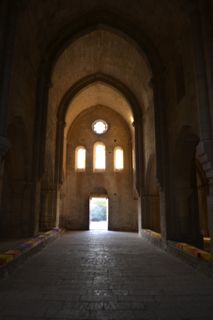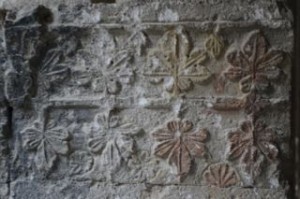Fighting through Jacques Le Goff’s Culture of Medieval Europe I was punched down in the stomach. Well he says it was in the stomach, I think it was under the belt. I am still on my knees, grasping for breath. The umpire is counting, but I will get up before he has gotten to ten.
What happened? On page 112 Le Goff writes: ‘Romanesq simplicity is a cute but anachronistic creation of the 20th century.’
Cute!, anachronistic!. How dare he say something like that. The world that I have been creating for myself is falling apart. Those harmonious lines in the churches, those simple forms, those quiet stained glass windows, the careful sculptures. What if you would not call that simplicity? And then he adds, horror – I was already down so this punch was just in the sky – that in Gothic architecture the detail was finally made subservient to rigidity and regularity. Again, how dare he?
Thinking about it, todays remains of churches are hardly what they were in the 12th century. Colour being the main difference. Ceilings and sculptures were almost always painted. And not subtly, if we may believe what remains of some of the Romanesq fresques we have seen. If whole churches would have looked like that it would have been disquieting and something one does not refer to as ‘simplistic’.
So Le Goff might well have been right with his punch. It should be considered above the belt and it was my unrigourous thinking and rosey look that caused my unpreparedness.
I still do not agree with his view on Gothic arcitecture, but understand even better now what Bernard and his Cistercians were trying to achieve with his drastic reduction of nearly everything in the abbeys that were built in the 12th century.
We’ve seen six now. Only one is still used as a monastery, in Spain notably. Julie thinks the buildings are lifeless without a clear function, but for me they remain as close to perfection as I can imagine churches. The architectural superiority, the stillness of the design, the solemness of its structure, the emptiness really, it automatically causes a reflective mood that is absolutely impossible within the business and overwhelmingness of most Gothic structures.
But even these now deserted Cistercian buildings might have looked different in the time they were built. Looking at Sylvicane abbey, one of the three remaining Cistercian monasteries in the Provence, Julie found some remains of paint on one of the capitals in the cloister.
How did it get there. Bernard would never have approved of painted sculptures, I assume. He wanted his monks to concentrate on praying instead of their attention being diverted by something as frivolous as colour.
Anyway, I got myself on my feet again. The fight with Le Goff will go on. He’s quite brilliant in his choice of authentical sources, which makes the book more lively than I thought. He gives a clear economic explanation for all developments in society. Even the introduction of celibacy for priests somewhere around the 11th century is explained this way. Only without wives and children, the church could retain their material possessions – and economic power – without too much dispute. I felt like Bill Clinton was whispering in my ear: ‘it’s the economy, stupid’. Which is something I really always have thought.




Leave a Reply